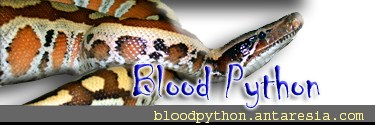Blood pythons ........ UPDATE IN PROGRESS
Blood python babies can be nervous and nippy, but this is usually just their strong defensive reflex.
Blood pythons used to be considered an aggressive species, but from my experience the captive bred babies
born from captive bred parents will be quite tame. My blood pythons were raised from incredibly tame hatchlings.
One of my females never ever showed any signs of shiness or aggression, and she grew into a very tame and trusting
impressive snake, a real pleasure to handle.
Blood python hatchlings can be started on mice or rats, and later offered new born rabbits. Most of my blood pythons
took anything offered, as long as it was of the right size. The rodents should be about the same diameter as the snake's
girth.
Some blood python babies will refuse to feed, but there are few methods of helping them to overcome this period.
The most important thing is to have the snake feeling secure. Food can be offered in their enclosure, or in a seperate feeding container - which
is the preffered methond. A reluctant feeder can be placed in a smaller, dark container, or a paper bag. They should never be fed
live rodents - unless this is the only food they will take. Most hatchlings will start on frozen and thawed or freshly killed
rats or mice left on the floor of the cage. Reflex feeding is not recommended, but these are intelligent snakes and will learn to
regognize their keeper.
The enclose for blood python babies should be not too big. Having it a bit smaller than larger can be actually beneficial - it will make the snake
feel secure and easier to keep and feed. There should be always a dish with fresh water available, best would be one which is
big enough so the little blood python can enter it and soak - which they love to do. Keeping the hmidity a bit higher than
for other snakes is recommended, but the cage shouldn't be 'dripping wet' with water. Occasional misting and a large dish will
usually be sufficient to have the humidity level at about 60%.
Just like any other snakes, blood pythons need cool and warm end witha basking area at about 90 F. The cool end should be at about 80 F.
The best substrate is somethign simple from my experience, and I always use newsprint. It is easy to clean and change when necessary.
Aspen shaving are also good, but if for any reason the snake will spill the water and the enclosure will become wet, the dump aspen
seems to make it's way into the snakes mouth and it always ends up with the necessity of having the aspen bits and pieces removed
from it usung tweezers.

